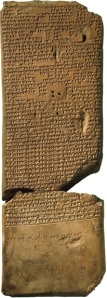The spirito-mystical trinity that composes the ancient pantheon is concluded with Enki, brother of Enlil. Most genealogies, particularly emphasized by post-Sumerian civilizations, will conclude that Enki and Enlil are, in actuality, half-brothers. Both are divine sons of Anu, the “Sky-Father,” but as heir to “Kingship of Heaven,” En-lil is reported as the son of Antu (the “official” consort of Anu), while Enki is descended from Nammu [which is often equated to Tiamat in Babylonian lore and perhaps the justification of the descent of Marduk from Tiamat in some versions]…
 [This mardukite.com blog post is officially excerpted from Mardukite Liber 50, originally released as SUMERIAN RELIGION, with materials also found in the newly released anthology MESOPOTAMIAN RELIGION by Joshua Free. The Mardukite Year-2 Anthology, Gates of the Necronomicon, also contains these materials.]
[This mardukite.com blog post is officially excerpted from Mardukite Liber 50, originally released as SUMERIAN RELIGION, with materials also found in the newly released anthology MESOPOTAMIAN RELIGION by Joshua Free. The Mardukite Year-2 Anthology, Gates of the Necronomicon, also contains these materials.]
Other cuneiform texts reveal Enlil as the eldest son of KI and Enki as the son of Antu. These differing lineages play a more significant role in the younger pantheon and later dualistic interpretations, but in the original formation of Sumerian civilization, Enlil and Enki are actually perfect compliments to one another in the division of the material world – Enlil as the ruler of the air and fire aspects, leaving Enki the domains of water and earth.
 As the Sumerian “Enki” form is relayed, the title suggests quite simply that he is “Lord of the Earth” [EN = Lord, KI = earth], later being relayed by the Babylo-Akkadian epitaph “Ea,” likely derived from the Sumerian ideograms for “house” [E] and “water” [A]. This water alignment is suggested further by the titles given to his temple-ziggurat, built in the southern city of Eridu [e-ri-dug – “home of the mighty”] known as both E.ENG-URA (House of Lower Waters) or E.ABZU (House in the Depths).
As the Sumerian “Enki” form is relayed, the title suggests quite simply that he is “Lord of the Earth” [EN = Lord, KI = earth], later being relayed by the Babylo-Akkadian epitaph “Ea,” likely derived from the Sumerian ideograms for “house” [E] and “water” [A]. This water alignment is suggested further by the titles given to his temple-ziggurat, built in the southern city of Eridu [e-ri-dug – “home of the mighty”] known as both E.ENG-URA (House of Lower Waters) or E.ABZU (House in the Depths).
Where Enlil is given charge over the organization of “space” and the management of the other deities, Enki is given more control over “worldly matters” and carries the designation of forty. In essence, Enlil represents the active spirit that is the manifested world as a whole and why it can exist (separated from the “heavens”). By comparison, Enki represents the more passive elements, but clearly the more “material” ones, and also the spirit of how things exist – their “hidden” internal engineering and atomistic design.
“Here in Eridu there was a local deity by the name of Ea, and the aspiring theologians of that city, eager to make him the supreme deity of the land, pressed forward the claim for lordship over the earth, and in an effort to insure his claim applied to him the epithet en-ki, ‘Lord of the Earth,’ which then became his Sumerian name. But though Enki, after some centuries, did succeed in displacing Ninhursag [Belit, etc.] and taking third place in the pantheon, he failed to topple Enlil from his supremacy and had to settle and had to settle for second best, becoming an Enlil-banda, a kind of ‘Junior Enlil.’ Like other gods he had to travel to Nippur to obtain Enlil’s blessing after he had built his his temple E’engurra in Eridu; he had to fill the Ekur of Nippur with gifts and possessions so that Enlil might rejoice with him; though he had charge of the Me controlling the cosmos and all civilized life, he had to admit that these were turned over to him by a generous and more powerful Enlil.”
S.N. Kramer, Sumerian Mythology, 1944
The properties and position of Enki as establishing the material basis and infrastructure of civilization was observed most famously in an epic dedicated to the figure “Oannes” as recorded by a Babylonian priest, Berossus, in the 13th Century B.C. In this narrative, Enki is depicted as the “sublime fish god” [fish = scales = reptillian] who rises from his ocean home (or in this case, the Erythian Sea near the Persian Gulf) to teach men the crafts necessary for their developmental arts and sciences to flourish.
For more information on ENKI and the ANUNNAKI, explore the World of the Mardukites today!











ARE ENLIL AND ENKI spirits? Was Adam in this timeline? Also When was the big War of all the Spirits? {Angels} [ Devils] [ gods]???
Pingback: New Babylon Rising – Mesopotamian Anunnaki Gods & The Mardukite Necronomicon, Lughnassadh Issue 2014 | BABYLON 3.0 - A Brave New Babylonian Rising